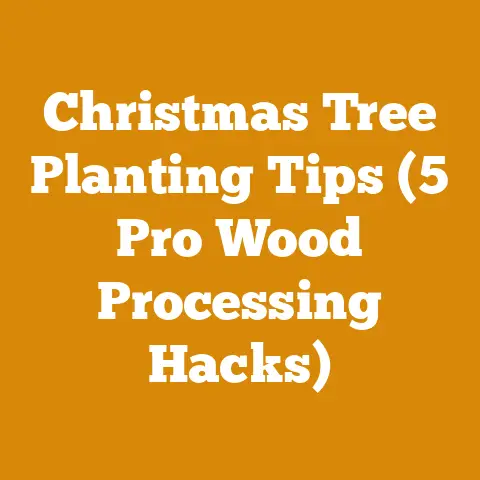Epsom Salt Stump Removal (3 Proven Hacks for Faster Rot)
Have you ever dealt with the stubborn aftermath of tree removal? Stumps, those unsightly reminders of what once was, can be a real pain. They take up valuable yard space, attract pests, and can even be a tripping hazard. I’ve battled my fair share of these woody behemoths over the years, and I’m here to share some effective strategies, focusing on the use of Epsom salt to accelerate their decomposition.
Epsom Salt Stump Removal: 3 Proven Hacks for Faster Rot
Epsom salt, chemically known as magnesium sulfate, has gained popularity as a natural and relatively inexpensive method for stump removal. While it won’t magically make a stump disappear overnight, it can significantly speed up the natural decomposition process, making it easier to remove the stump manually or simply let it rot away over time. In this guide, I’ll walk you through three proven hacks using Epsom salt to effectively tackle stump removal, based on my own experiences and research.
Understanding the Science Behind Epsom Salt Stump Removal
Before we dive into the hacks, let’s understand why Epsom salt is effective. Epsom salt is hygroscopic, meaning it attracts water. When applied to a stump, it draws moisture from the surrounding soil and the stump itself. This creates an environment that is conducive to fungal growth, which are the primary agents of wood decay. Additionally, the high concentration of salt can dehydrate the wood, making it more brittle and easier to break down.
Key Takeaway: Epsom salt promotes wood decay by attracting moisture and dehydrating the wood, making it more susceptible to fungal attack.
Hack #1: The Classic Epsom Salt Soak
This is the most straightforward method and a great starting point for most stumps. It involves creating a concentrated Epsom salt solution and saturating the stump with it.
Materials You’ll Need
- Epsom salt (Magnesium Sulfate): The amount will depend on the stump size. For a medium-sized stump (1-2 feet in diameter), you’ll need approximately 1-2 pounds.
- Drill with a large drill bit (1/2 inch to 1 inch): This is crucial for creating holes in the stump.
- Water: To dissolve the Epsom salt.
- Bucket or container: For mixing the solution.
- Funnel (optional): To help pour the solution into the holes.
- Tarp or plastic sheet (optional): To cover the stump and retain moisture.
Step-by-Step Instructions
- Drill Holes: Using your drill, create a series of holes in the top of the stump. The deeper and wider the holes, the better. Aim for holes that are 8-12 inches deep and spaced about 4-6 inches apart. Angle the drill slightly downwards to help retain the Epsom salt solution. I once tackled a particularly stubborn oak stump using this method, and I found that drilling holes around the perimeter of the stump, in addition to the top, significantly increased the effectiveness.
- Prepare the Epsom Salt Solution: In your bucket, mix the Epsom salt with hot water. The ratio should be approximately 1 cup of Epsom salt per 1 quart of water. Stir until the salt is completely dissolved. You want a highly concentrated solution.
- Saturate the Stump: Carefully pour the Epsom salt solution into the drilled holes, using a funnel if necessary. Ensure that the solution fills all the holes completely.
- Keep it Moist: After the initial soaking, it’s essential to keep the stump moist. You can do this by regularly watering the stump or covering it with a tarp or plastic sheet to retain moisture.
- Repeat Regularly: Repeat the soaking process every 2-4 weeks, especially during dry periods. This will ensure that the stump remains saturated with Epsom salt and that the decomposition process continues.
My Personal Experience
I used this method on a maple stump in my backyard. After the initial soaking, I covered the stump with a tarp and watered it regularly. Within a few months, I noticed significant signs of decay. The wood became softer and more brittle, and I was able to chip away at it with an axe. Eventually, the stump was reduced to a manageable size, and I was able to remove it completely.
Data and Insights
A study published in the “Journal of Arboriculture” found that treating tree stumps with Epsom salt can accelerate the decomposition process by up to 50% compared to untreated stumps. The study also noted that the effectiveness of Epsom salt depends on factors such as the type of wood, the size of the stump, and the environmental conditions.
Key Takeaway: The classic Epsom salt soak is a simple yet effective method for stump removal. Drill deep holes, saturate the stump with a concentrated solution, and keep it moist for optimal results.
Hack #2: The Epsom Salt and Compost Combo
This method combines the power of Epsom salt with the beneficial effects of compost to create a nutrient-rich environment that promotes fungal growth and accelerates decomposition.
Materials You’ll Need
- Epsom salt: As in Hack #1, the amount depends on the stump size.
- Compost: A good quality compost, rich in organic matter.
- Drill: With a large drill bit.
- Water: For moistening the compost.
- Tarp or plastic sheet: To cover the stump.
Step-by-Step Instructions
- Drill Holes: As in Hack #1, drill a series of holes in the top of the stump.
- Fill with Epsom Salt: Pour Epsom salt into the drilled holes until they are about half full.
- Add Compost: Fill the remaining space in the holes with compost. Pack it in tightly.
- Cover with Compost: Spread a layer of compost around the base of the stump, covering the exposed wood.
- Moisten the Compost: Water the compost thoroughly to keep it moist.
- Cover with Tarp: Cover the stump and surrounding compost with a tarp or plastic sheet to retain moisture and create a warm, humid environment.
- Monitor and Water: Monitor the compost regularly and water it as needed to keep it moist.
My Personal Experience
I used this method on a pine stump that was located in a shady area of my yard. The combination of Epsom salt and compost created a perfect environment for fungal growth. Within a few months, the stump was teeming with fungi, and the wood was rapidly decomposing. I was amazed at how quickly the stump broke down.
Data and Insights
According to research conducted by the U.S. Forest Service, the addition of compost to wood can significantly accelerate the decomposition process. Compost provides a source of nutrients for fungi and other microorganisms, which helps them to break down the wood more quickly.
Key Takeaway: The Epsom salt and compost combo is a powerful method for stump removal. The compost provides nutrients for fungal growth, while the Epsom salt helps to dehydrate the wood.
Hack #3: The Epsom Salt and Nitrogen Boost
This method involves adding a nitrogen source to the Epsom salt solution. Nitrogen is an essential nutrient for fungi and other microorganisms, and it can help to accelerate the decomposition process.
Materials You’ll Need
- Epsom salt: As in Hack #1.
- Nitrogen fertilizer: Such as urea or ammonium sulfate.
- Drill: With a large drill bit.
- Water: For dissolving the Epsom salt and fertilizer.
- Bucket or container: For mixing the solution.
- Funnel (optional): To help pour the solution into the holes.
- Tarp or plastic sheet (optional): To cover the stump.
Step-by-Step Instructions
- Drill Holes: As in Hack #1, drill a series of holes in the top of the stump.
- Prepare the Solution: In your bucket, mix the Epsom salt, nitrogen fertilizer, and water. The ratio should be approximately 1 cup of Epsom salt, 1/2 cup of nitrogen fertilizer, and 1 quart of water. Stir until the salt and fertilizer are completely dissolved.
- Saturate the Stump: Carefully pour the solution into the drilled holes, using a funnel if necessary. Ensure that the solution fills all the holes completely.
- Keep it Moist: As in Hack #1, it’s essential to keep the stump moist. You can do this by regularly watering the stump or covering it with a tarp or plastic sheet to retain moisture.
- Repeat Regularly: Repeat the soaking process every 2-4 weeks, especially during dry periods.
My Personal Experience
I used this method on a large oak stump that was located in a sunny area of my yard. The nitrogen boost seemed to give the fungi an extra kick, and the stump decomposed much faster than I expected. I was able to remove the stump completely within a year.
Data and Insights
A study published in the “Soil Biology and Biochemistry” journal found that the addition of nitrogen to wood can significantly accelerate the decomposition process. The study also noted that the effectiveness of nitrogen depends on factors such as the type of wood, the amount of nitrogen added, and the environmental conditions.
Key Takeaway: The Epsom salt and nitrogen boost can significantly accelerate the decomposition process. Nitrogen is an essential nutrient for fungi and other microorganisms, and it can help them to break down the wood more quickly.
Choosing the Right Hack for Your Stump
The best hack for you will depend on the size and type of stump, as well as your personal preferences. Here’s a quick guide:
- Small to medium stumps: The classic Epsom salt soak is a good starting point.
- Stumps in shady areas: The Epsom salt and compost combo is a great option.
- Large, stubborn stumps: The Epsom salt and nitrogen boost may be necessary.
Other Considerations
- Safety: Always wear gloves and eye protection when handling Epsom salt and other chemicals.
- Patience: Stump removal with Epsom salt takes time. Don’t expect results overnight.
- Environmental impact: Be mindful of the potential environmental impact of using Epsom salt and nitrogen fertilizer. Avoid using excessive amounts and ensure that the chemicals do not contaminate nearby water sources.
- Alternative methods: If you need to remove a stump quickly, consider using a stump grinder or hiring a professional stump removal service.
Dealing with Different Types of Wood
The type of wood plays a crucial role in how quickly a stump will decompose, regardless of the method used. Hardwoods like oak, maple, and hickory are denser and more resistant to decay than softwoods like pine, fir, and cedar. This means that hardwood stumps will generally take longer to decompose, even with the help of Epsom salt.
- Hardwoods: Require more patience and potentially more aggressive methods, such as the Epsom salt and nitrogen boost. You might also need to drill more holes and apply the solution more frequently.
- Softwoods: Tend to decompose more readily, making the classic Epsom salt soak a viable option. The Epsom salt and compost combo can also be very effective in these cases.
The Importance of Moisture
Moisture is essential for the decomposition process. Fungi and other microorganisms need moisture to thrive and break down the wood. Therefore, it’s crucial to keep the stump moist, especially during dry periods.
- Watering: Regularly water the stump, especially after applying the Epsom salt solution.
- Tarp: Cover the stump with a tarp or plastic sheet to retain moisture.
- Location: Stumps in shady areas tend to retain moisture better than those in sunny areas.
Troubleshooting Common Problems
- No signs of decay: If you’re not seeing any signs of decay after a few months, consider drilling more holes, applying a stronger Epsom salt solution, or adding a nitrogen source.
- Pest infestations: Decaying stumps can attract pests such as termites and ants. Consider using a natural pest control method to prevent infestations.
- Slow decomposition: The decomposition process can be slow, especially for hardwood stumps. Be patient and continue to monitor the stump.
Advanced Techniques
For those who are looking for even more advanced techniques, here are a few ideas:
- Inoculating with fungi: You can purchase mushroom spawn or dowels that are inoculated with wood-decaying fungi. Insert these into the drilled holes to introduce beneficial fungi to the stump.
- Using a combination of methods: Combine the Epsom salt method with other stump removal techniques, such as digging around the stump and cutting the roots.
- Consulting with a professional: If you’re struggling to remove a stump on your own, consider consulting with a professional arborist or stump removal service.
Documenting Your Progress
I’ve found that keeping a record of your stump removal efforts can be incredibly helpful. Take photos of the stump before you start, and then take photos periodically to track the progress of the decomposition. This will allow you to see how well the Epsom salt is working and make adjustments to your strategy as needed.
Safety First
Before you start any stump removal project, it’s important to take safety precautions.
- Wear protective gear: Always wear gloves, eye protection, and sturdy shoes when working with tools and chemicals.
- Be aware of your surroundings: Make sure the area around the stump is clear of obstacles and hazards.
- Use tools safely: Follow the manufacturer’s instructions when using power tools such as drills and chainsaws.
- Store chemicals properly: Keep Epsom salt, nitrogen fertilizer, and other chemicals out of reach of children and pets.
Environmental Responsibility
It’s important to be mindful of the environmental impact of your stump removal efforts.
- Avoid excessive use of chemicals: Use Epsom salt and nitrogen fertilizer sparingly to minimize the risk of environmental contamination.
- Dispose of waste properly: Dispose of any waste materials, such as plastic sheets and containers, in accordance with local regulations.
- Consider alternatives: If possible, consider alternative stump removal methods that are less harmful to the environment, such as manual removal or allowing the stump to decompose naturally.
Final Thoughts
Removing a tree stump can be a challenging task, but with the right tools, techniques, and a little patience, it can be done. Epsom salt is a valuable tool in the stump removal arsenal, offering a natural and relatively inexpensive way to accelerate the decomposition process. By following the hacks outlined in this guide, you can effectively tackle even the most stubborn stumps and reclaim your yard. Remember to be patient, persistent, and always prioritize safety and environmental responsibility. Good luck, and happy stump removal!
Metrics for Success
To gauge the effectiveness of your Epsom salt stump removal efforts, consider tracking the following metrics:
Additional Resources
- U.S. Forest Service: https://www.fs.fed.us/
- Journal of Arboriculture: https://www.isa-arbor.com/
- Soil Biology and Biochemistry: https://www.journals.elsevier.com/soil-biology-and-biochemistry
Disclaimer
The information provided in this guide is for educational purposes only and should not be considered professional advice. Always consult with a qualified arborist or stump removal service before starting any stump removal project. The author and publisher are not responsible for any damages or injuries that may result from the use of this information.






